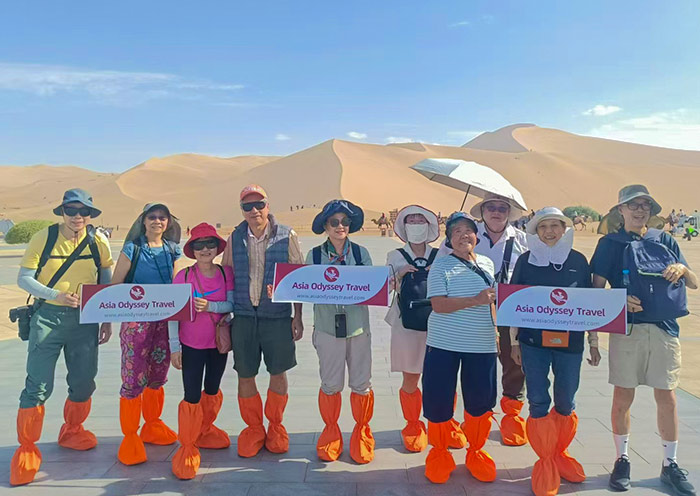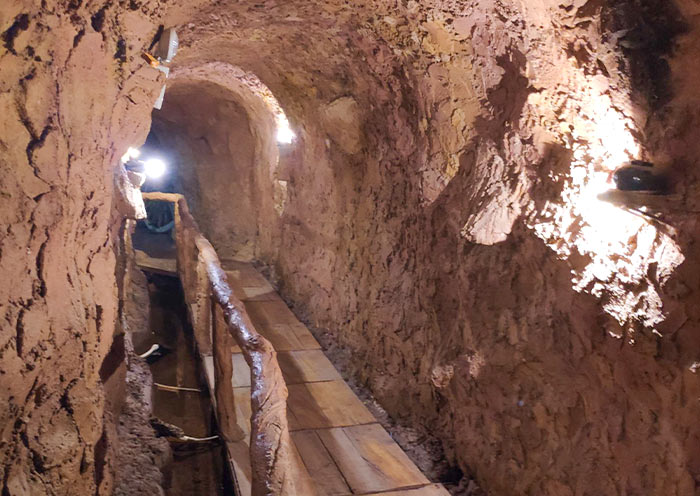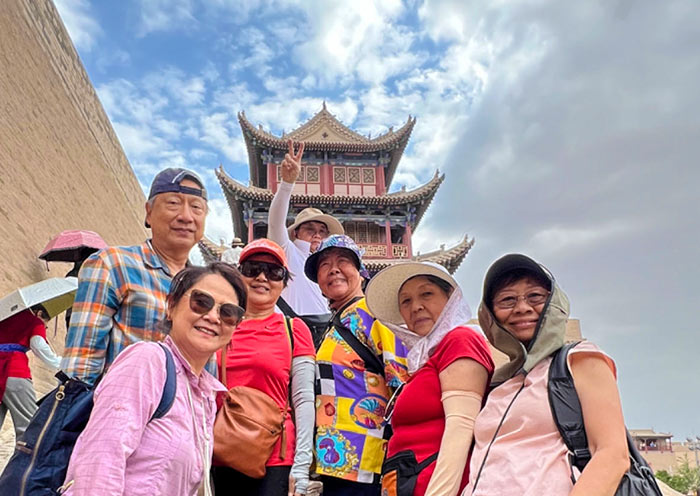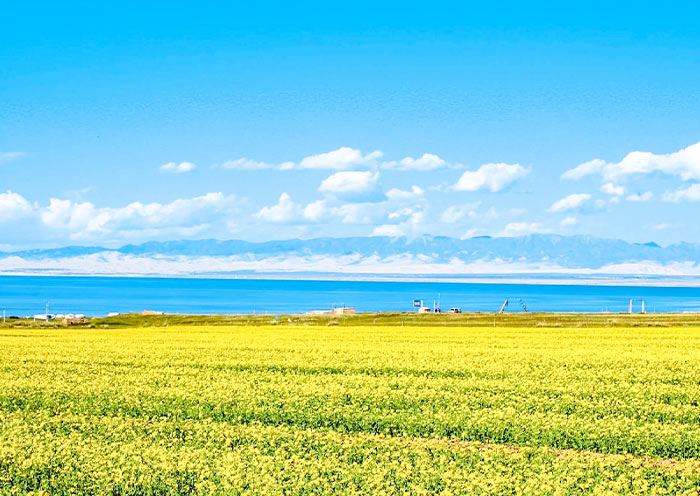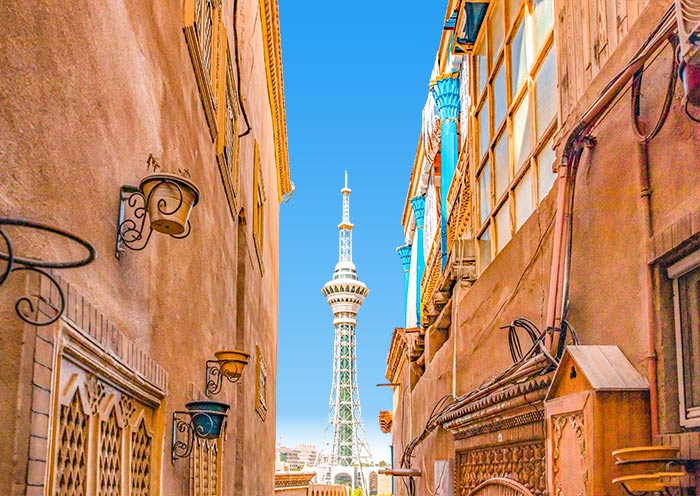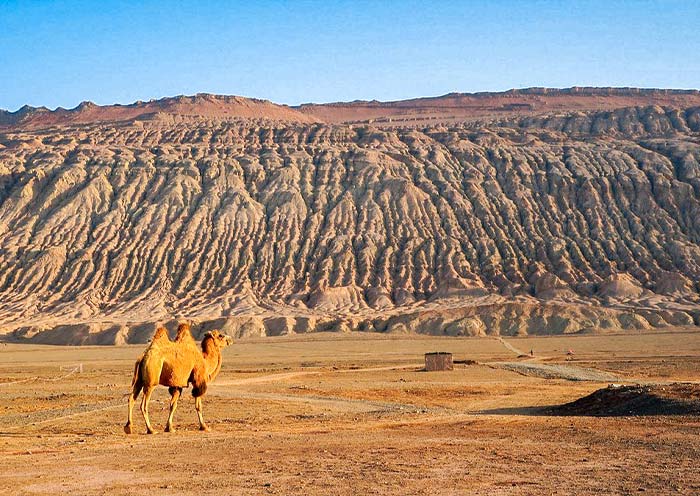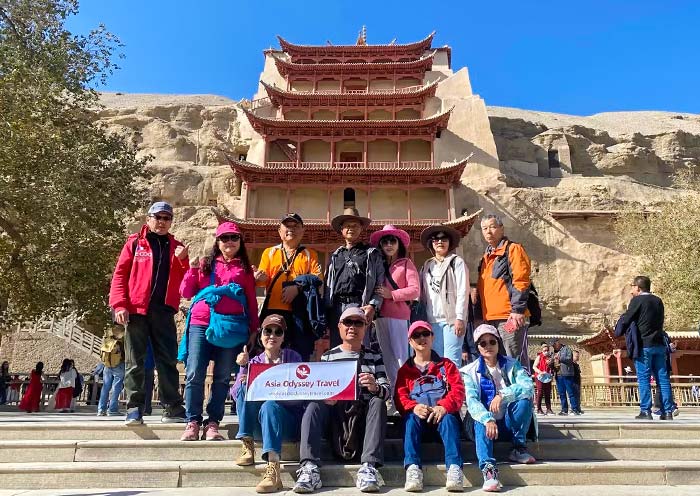10 Days Classic Silk Road Group Tour (Xinjiang, Gansu & Qinghai)

-
Tour Code: AOT-SRT-C
-
Travel Route: Urumqi - Turpan - Dunhuang - Jiayuguan - Zhangye - Xining - Qinghai Lake - Chaka Salt Lake - Xining
-
Features: Silk Road, Ruins, Buddha Caves, World Heritage, Ethnic Culture, Bazaars & Markets, Art and Handicrafts, Food & Cuisine, Mountains, Sands, Lake, Danxia
-
Tour Type: Small Group of maximum 25 travelers, guaranteed departures;
-
Guide & Driver: English-speaking guide, experienced driver with regular tourist vehicle
-
Accommodation: 9 Nights at 3 Star Standard Hotel
- Itinerary
- Dates & Price
- Accommodation
- Trip Notes
- Reviews
Are you ready to explore the legendary Ancient Silk Road? How long would you like to trace its path? Spanning 7,000 kilometers, this historic network of trade routes connects China to Central Asia. Xinjiang, in northwestern China, and its capital city, Urumqi, serve as a popular GATEWAY to start your Silk Road adventure.
Join our 10-day Classic Silk Road group tour and discover iconic destinations (Xinjiang, Gansu, Qinghai) rich in history, culture, and natural beauty. Starting in Urumqi, the vibrant hub of Northwestern China, you'll embark on a cultural odyssey that highlights the region’s diverse landscapes and traditions.
Explore the oasis of Turpan, where you'll find the ancient Jiaohe ruins and the ingenious Karez irrigation system. In Gansu, marvel at the treasures of the Hexi Corridor, including the stunning Mogao Caves in Dunhuang, the Great Wall at Jiayuguan, and the colorful Danxia landforms in Zhangye. Conclude your journey in the breathtaking landscapes of Qinghai, where you can unwind in nature's tranquility.
This classic Silk Road group tour not only unveils the historical significance of the Silk Road but also showcases the remarkable transformation of cultures and scenery along the way. Join us for an extraordinary journey through time!
Itinerary at a Glance
Urumqi (2 Days)
Heavenly Lake of Tianch, Bodga Mountain View, Urumqi Grand Bazaar
Turpan (1.5 Day)
Tuyoq Village, Jiaohe Ancient City Ruins, Karez System, Emin Minaret
Dunhuang (1.5 Days)
Mogao Grottoes, Singing Sand Dunes & Crescent Spring
Jiayuguan (1 Day)
Jiayuguan Pass, Overhanging Great Wall
Zhangye (1 Day)
Zhangye National Geopark (Zhangye Danxia Geological Park), Dafo Temple (Big Buddha Temple)
Xining (0.5 Day)
High speed train to Xining
Qinghai Lake (0.5 Day)
Erlangjian Scenic Area, Rapeseed Fields, Optional Cruise Experience on the Qinghai Lake
Chaka Town (1 Day)
Chaka Salt Lake, Mirror of the Sky Scenic Area
Xining (1 Day)
Ta’er Monastery, Depart from Xining city
Itinerary Day by Day
Ni Hao! Welcome to Urumqi, the capital of Xinjiang Uygur Autonomous Region! Our local Urumqi tour guide will wait for you and your travel companions in the same group at the arrival hall of the airport and will escort you directly to the downtown area. The guide will assist your group with checking into your hotel. (Note: please tell us your schedule in advance.)
Urumqi (乌鲁木齐), the capital of the Xinjiang Uygur Autonomous Region in China, notable for being the most landlocked major city in the world, far from any sea or ocean. Historically, Urumqi played a significant role as a major stop on the Silk Road, facilitating trade between China and the West. This history has left a lasting impact, making Urumqi a melting pot of ethnic groups, including Uyghurs, Han Chinese, Kazakhs, and others, each contributing to the city's vibrant culture. Naturally, the city is surrounded by the stunning Tianshan Mountains. And, it boasts attractions like the Xinjiang Regional Museum, where visitors can learn about the region's history and see artifacts. The International Grand Bazaar in Urumqi is another highlight, offering a taste of local life with its array of spices, textiles, and crafts.
Arrival Ideas: Urumqi Diwopu International Airport (IATA: URC) serves as the main airport for Urumqi, the capital of Xinjiang Uygur Autonomous Region in China. Urumqi Diwopu International Airport offers flights to many major cities across China like Beijing (about 4 hours), Xian (about 3.5 hours), Shanghai (about 5.5 hours), Guangzhou (about 5 hours), Chengdu (about 3.5 hours), Lanzhou (about 2.5 hours), etc. It is also a vital hub for flights to Central Asian cities, including Islamabad, Almaty, Astana (now Nur-Sultan), Dushanbe, Istanbul, and Tehran,etc.
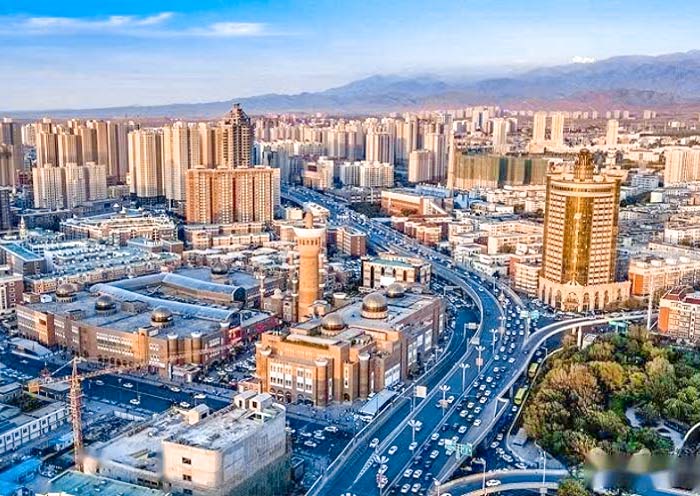

Attractions
free exploration
Transportation
coach
Dining
Breakfast
Accommodation
Urumqi
Today, you'll embark on a full-day exploration, from the breathtaking natural beauty of Tianshan Tianchi Lake to the enlightening exhibits at the Xinjiang Regional Museum.
In the morning, you'll be driven approximately 70 kilometers (about 1-1.5 hours) to Heavenly Lake of Tianshan (天山天池), a UNESCO World Heritage Site. Nestled at an elevation of around 1,980 meters (6,500 feet) above sea level, this serene alpine lake is surrounded by lush forests, snow-capped peaks, and breathtaking landscapes. Renowned for its crystal-clear waters, panoramic Bogda mountain views, and connections to ancient myths and legends, Heavenly Lake is a must-see. One such legend involves the Queen Mother of the West (Xi Wangmu), who is said to have hosted a banquet for the Eight Immortals here.
Upon arrival, you'll first take 40-minute sightseeing bus ride through the dramatic mountains. Then, enjoy 10-minute walk to the picturesque lake. Enjoy a leisurely stroll around Heavenly Lake, taking in the fresh mountain air and diverse flora and fauna.
Optional Activities (additional fee required):
- Boat Ride: Cruise across the peaceful waters of the lake, immersing yourself in its beauty and the reflections of the snow-capped mountains.
- Cableway Ride: Take a cableway up to Mayashan for even more stunning views of Bogda Mountain.
After lunch, return to Urumqi and visit the Urumqi Grand Bazaar, also known as the Xinjiang International Grand Bazaar, is a vibrant marketplace and a perfect way to spend your free time. Explore the many shops and stalls offering various local products, including traditional Uyghur clothing, carpets, handmade crafts, silk scarves, jewelry, spices, and dried fruits. Be sure to try local favorites such as lamb kebabs, polu (pilaf), naan bread, and laghman (hand-pulled noodles). Additionally, the architecture of the Grand Bazaar itself is worth admiring with its grand minarets, domes, and intricate Islamic-inspired designs.
After the tour, return to your hotel in Urumqi.

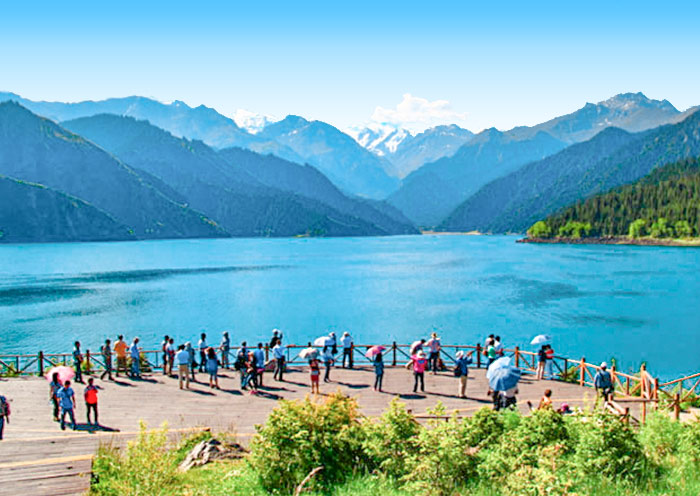
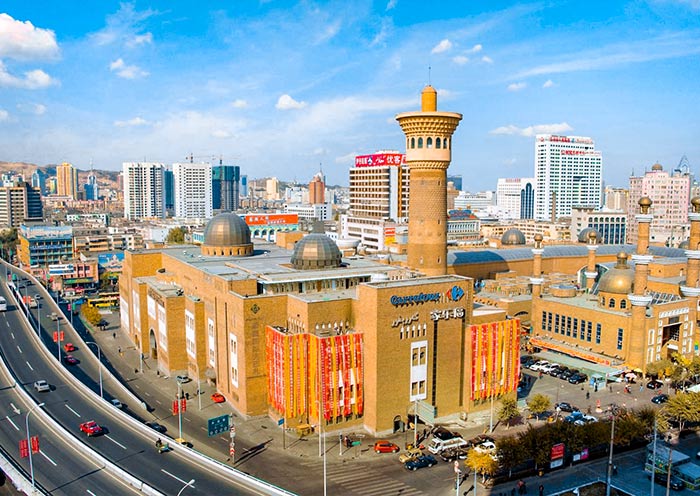
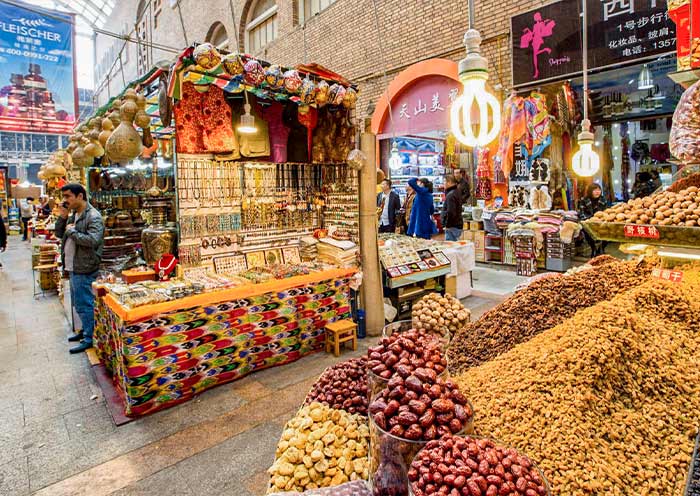
Attractions
2 sites
Transportation
coach, sightseeing bus
Dining
Breakfast
Accommodation
Urumqi
After breakfast, embark on a scenic 3-hour drive (180 km) from Urumqi to Turpan. Along the way, you’ll pass the striking Salt Lake and the impressive wind power station, the largest in Asia, at the foot of the Tianshan Mountains.
Turpan (吐鲁番) is located in the eastern part of Xinjiang. Situated in the Turpan Depression at 154 m below sea level, it's the second-lowest depression in the world and the hottest spot in China, earning it the nickname "Fire Land."
Despite its arid climate, the ingenious Karez irrigation system has transformed this desert region into a fertile oasis, renowned for its agriculture, especially grape production. As a crucial stop on the ancient Silk Road, Turpan served as a hub for trade and cultural exchange between East and West. The area is dotted with historical sites - ancient city ruins, remnants of fortifications, and Buddhist cave complexes - testifying to its rich cultural roots.
Upon arrival in Turpan, you will drive to Tuyoq Valley along the Flaming Mountain Grand Canyon. The Flaming Mountains (Huoyan Shan), named for their intense heat and reddish-brown sandstone that appears to glow like fire under the desert sun, are one of Turpan’s most iconic landscapes. Stretching over 100 kilometers from east to west, these eroded hills create a striking, otherworldly view. Along the way, we can stop for photos.
The winding road along the cliffs of the Flaming Mountains will soon lead you to Mazar Village (麻扎村), nestled in the Tuyoq Valley (吐峪沟). It is the oldest surviving Uyghur village, with a history of over 1700 years. The mud-constructed town offers a glimpse of traditional Uighur life and architecture. Here, every household grows mulberry, apricot, or jujube trees around their homes. The doors are adorned with colorful paintings of flowers and fruits, and the window lattices are also decorated with a variety of motifs. The ancestors of Mazar Village, adapting to the local environment and survival needs, ingeniously used locally sourced yellow clay to construct their homes. This has resulted in one of the best-preserved earthen architecture complexes in China today. The earth-toned dwellings adorned with colorful door frames, set against the backdrop of red mountains, are extremely photogenic.
Next, visit to Jiaohe Ancient City (交河故城), one of the best-preserved ruins of ancient cities along the Silk Road and inscribed on the UNESCO World Heritage List as part of the joint application "Silk Roads: the Routes Network of Chang'an-Tianshan Corridor." Jiaohe Ruins offers a profound glimpse into ancient city planning and the historical complexity of the civilizations on the Silk Road.
Nestled between two deep river valleys, Jiaohe, meaning "the confluence of two rivers," is strategically positioned on a large, steep plateau that provides formidable natural defenses. As a key city connecting the Central Plains (中原) and the vast regions of the Western Regions (西域), Jiaohe Ancient City played a vital role in the transportation network of the Silk Road. It witnessed the bustling trade along the Silk Road and the exchange and integration of Eastern and Western cultures.
Unlike many ancient cities, its structures were not built up from the ground but carved down into the existing plateau of loess soil. Walking through the ruins, you can see the remains of government offices, residential houses, Buddhist stupas, and temples. These remnants not only provide important physical evidence for studying the history and culture of the Silk Road but also offer valuable insights into the social, economic, and religious life that shaped this region. Tips: There is no shelter inside the ruin, so be mindful of sun protection.
The History of Jiaohe Ancient City
The Ancient City of Jiaohe witnessed the development of civilization in the Western Region and the Silk Road. Approximately 2,000 years ago, it was established as the capital of the Jushi Kingdom (车师国), one of the 36 kingdoms in the Western Regions (西域三十六国). Following Zhang Qian's pioneering efforts during the Western Han Dynasty to carve a path through the Western Regions, Jiaohe City emerged as a crucial hub on the Silk Road. In 60 BC, the Han Dynasty central government established the Protectorate of the Western Regions (西域都护府) to administer the various states in the region, officially incorporating the Western Regions into the Chinese domain. During the Northern and Southern Dynasties, Jiaohe became a county under the jurisdiction of Gaochang(高昌). The city reached its zenith during the Tang Dynasty with the establishment of the Anxi Protectorate (安西都护府), marking a new era in the governance of the Western Regions. During this period, Jiaohe was a bustling center of international trade and vibrant cultural exchanges among diverse ethnic groups. From the 19th to the 14th century, due to the impact of wars, Jiaohe gradually declined and eventually became a ruin.
Afterwards, head to the Karez System (坎儿井) to learn about the ancient underground irrigation system a few thousand years ago and how this system has benefitted the people along the desert's edge, transforming barren land into a lush oasis. This traditional engineering marvel is considered one of China’s three great ancient engineering projects, alongside the Great Wall and the Grand Canal. It has been recognized in the 2024 World Irrigation Project Heritage list.
The origin of the Karez Irrigation System
Turpan, in Xinjiang, is one of China's most arid regions, with annual rainfall of only 16 millimeters and evaporation exceeding 3,000 millimeters. These extreme conditions have led to severe surface water scarcity. To improve their survival prospects, people ingeniously utilized the natural slope of mountains to channel underground rainwater, glacial melt, and snowmelt from spring and summer to the surface for irrigation. This method greatly reduced water loss through surface evaporation, meeting the water needs of this arid region. It’s often said, "Without the Karez, there would be no Turpan; without the Karez, there would be no civilization in Turpan." The Karez has turned extremely arid basins into green havens, making Turpan a crucial corridor for East-West exchanges along the Silk Road and a place where diverse cultures converge and coexist.
The Karez system is often referred to as the "Underground Great Wall". In Xinjiang, there are over 1,700 karez wells which, if connected, would stretch over 5,000 kilometers, forming a vast underground river network. It is estimated that the Karez system has a history of over 2,000 years. Imagine centuries ago, without modern measuring tools or mechanical assistance, how ancient people located underground water sources, determined the gradient and direction in complete darkness, and connected such lengthy channels. Today, you have the opportunity to step into the Karez and personally unravel the secrets of this most mysterious hydraulic engineering project, experiencing first-hand how ancient innovation works.
Next, continue your exploration at the Emin Minaret (额敏塔), the tallest Islamic minaret in Xinjiang. Also known as Sugong Ta (苏公塔), this remarkable structure was erected in 1778 by the local ruler Suleiman, in tribute to his father, Emin Khoja, whose considerable efforts helped maintain national unity.
It stands 44 meters (144 feet) tall and is made from sun-dried bricks, which give it a distinct, earthy color. The tower's cylindrical body tapers elegantly as it rises, topped by an ornate, pointed dome. Uyghur artisans crafted up to 15 different types of brick patterns, including waves, diamonds, floral clusters, and crosses, which create endlessly looping designs around the tower. Gazing up from beneath the tower, you can fully appreciate the simplicity and grandeur of these designs. The accompanying mosque is an integral part of the complex, which you can visit as well. Emin Minaret serves not only as a religious structure but also as a cultural icon for the Uyghur people, embodying a unique blend of Islamic and Uyghur architectural traditions.
After the tour, be escorted to your hotel in Turpan.
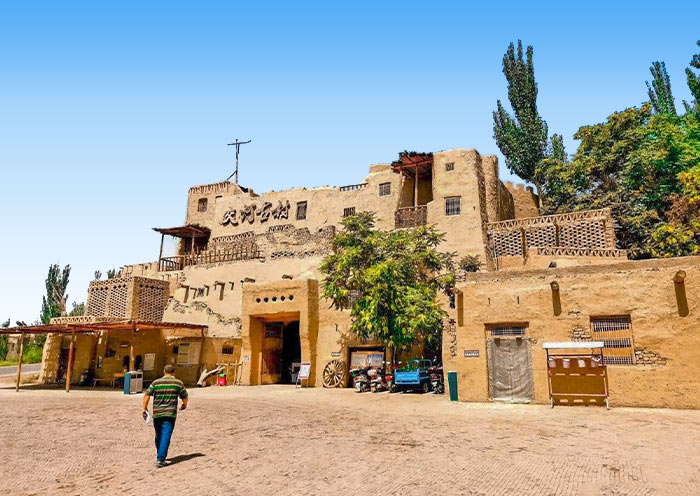
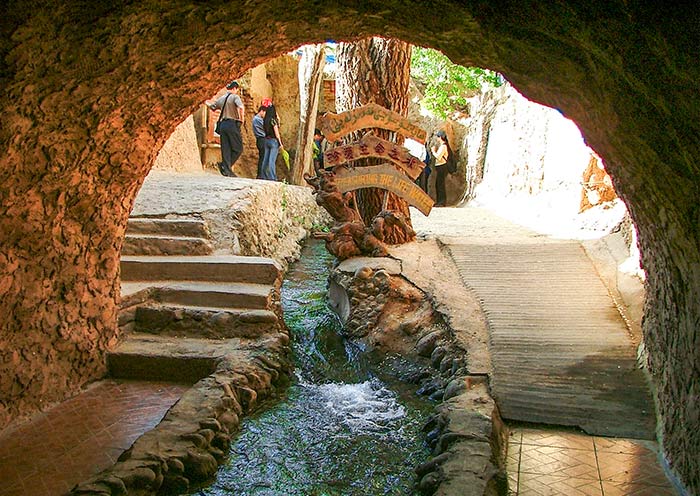


Attractions
4 sites
Transportation
coach
Dining
Breakfast
Accommodation
Turpan
Today, you'll be transferred to Turpan North Station to board the high-speed train to Liuyuan South Station. Upon arrival, your tour guide and driver will greet you at the exit and escort you to your hotel in Dunhuang (Distance 120km, about 2-hour drive).
Welcome to Dunhuang, a must-visit city located in the Gansu province of China! Upon arrival in Dunhang, your guide will meet you at the Liuyuan Train Station and escort you to your hotel. You can explore on your own based on your arrival time. Feel free to seek travel ideas from your tour guide.
Dunhuang, a city in Jiuquan (酒泉市), which was formerly known as Suzhou (肃州), is the birthplace of the "su" character in Gansu Province (甘肃的“肃”). Dunhuang is a desert oasis of ancient wonders. Discover the hidden gems of China's western frontier. Explore the breathtaking Mogao Caves, a UNESCO World Heritage Site adorned with vibrant murals and intricate sculptures. Trek through the Gobi Desert, marveling at the Crescent Lake's turquoise waters and towering sand dunes. From stargazing under pristine skies to experiencing the thrill of sandboarding, and camel riding, Dunhuang offers a captivating journey through time and nature. Dunhuang is also famous for Tunhuangology (敦煌学), a specialized field of study dedicated to exploring and interpreting the vast cultural and historical treasures in the Mogao Caves.
Free Time Ideas:
Dunhuang Shazhou Night Market (敦煌沙洲夜市) for Dunhuang food. There are many distinctive snacks that you must try, such as Apricot Skin Water (杏皮水), Donkey Meat Noodles (驴肉黄面), and Bubble Oil Cakes (泡儿油糕). The locals in Dunhuang enjoy eating lamb, chicken, and beef, and they are good at noodle making.

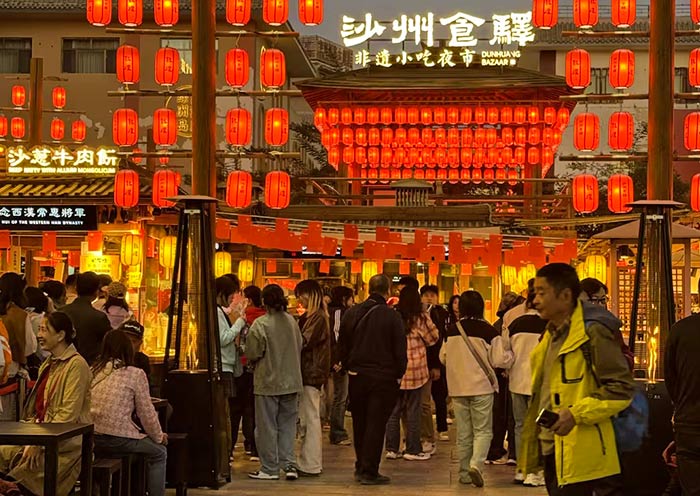
Attractions
/
Transportation
coach, high speed train
Dining
Breakfast
Accommodation
Dunhuang
Today, you will enjoy a wonderful Dunhuang Culture Tour by visiting Mogao Grottoes (4-4.5hrs), a UNESCO World Heritage site. You can enjoy the relaxing time in Echoing Sand Mountain & Crescent Lake, don’t miss the delicious food at the Shazhou Night Market.
Dunhuang Mogao Grottoes is the must-visit place for a trip to Gansu. You may read many stories about A. Stein (斯坦因a British archaeologist and explorer) and the vast trove of artifacts (Paintings, Sculptures, Manuscripts) he brought from the Mogao Grottoes in the early 20th century. You may have already seen the artifacts Stein collected in the British Museum in London. Or you may have heard of Paul Pelliot (French archaeologist & Sinologist) who like A. Stein, conducted several expeditions to Dunhuang and collected a large number of artifacts which is primarily housed in the Guimet Museum in Paris, France. Welcome to visit Mogao Grottoes the source of the world famous Dunhuang Manuscripts (Dunhuang Yi shu敦煌遗书; Cave 16-17) and explore valuable insights into the history and culture of the Silk Road.
The Mogao Caves (Mogao Grottoes莫高窟), also known as the Thousand Buddha Grottoes (千佛洞), are acclaimed as the "Treasure House of Eastern Art东方艺术宝库." The remaining 735 caves are dotted along cliffs rising about 15-30 m high and over 1,700 m, forming a magnificent spectacle of this world cultural heritage site. Despite the significant loss of artifacts to oversea museums, the Mogao Caves remain one of the world's largest and most richly endowed repositories of Buddhist art. Spanning sixteen kingdoms, Northern Wei, Western Wei, Northern Zhou, Sui, Tang, Five Dynasties, Song, and Western Xia dynasties, the construction of the Mogao Grottoes lasted for over a thousand years until the Yuan Dynasty, resulting in about 45,000 ㎡ murals and 2,415 clay sculptures. In the year 366 AD, the first cave of the Mogao Caves was carved into the cliff by the Monk Le Zun (乐僔; over 1,650 years ago). In the 7th century, Xuanzang (唐僧) translated numerous Buddhist scriptures at the Mogao Caves. In 1900, Daoist Wang (王圆箓) discovered the Library Cave (藏经洞; Sutra Cave; Cave 16). From 1941 to 1943, Zhang Daqian (张大千), a prodigious Chinese artist of the twentieth century, copied 276 murals here.
At the Mogao Caves, you can explore various types of grottoes (large statue caves, Nirvana caves, central pillar caves, vaulted ceiling caves, hall caves) and learn about the pigments used by ancient artists in painting murals (cinnabar, orpiment, azurite, mica, gamboge, gold leaf, shell powder). You can admire narrative paintings of Buddhist themes (the life of Shakyamuni Buddha, the Nine-Colored Deer Sacrificing Itself to Save Others), diverse clay sculptures (Buddha statues, Bodhisattva figures, guardians, deities), Flying Apsaras (飞天) and Swirling Dances (Sema; 胡旋舞) in the prosperous Tang Dynasty, as well as the attire and customs of patrons from various dynasties. At the Mogao Caves, you can witness the brilliance and charm of the ancient Silk Road and the efforts and achievements of generations of cultural heritage preservation workers and researchers (such as Chang Shuhong常书鸿, a Chinese painter known as the "guardian of Dunhuang"敦煌守护神).
You can start at the Mogao Caves Digital Center (莫高窟数字中心), watch a 40-minute digital film, and then take a shuttle bus to the caves. Guided by the site interpreters, you will visit 8 caves sequentially (Ticket A; no photography allowed inside the caves). You may have the chance to see significant caves like the Library Cave (Caves 16-17; the largest cave), the Nine-Storey Tower (Cave 96; one of Mogao's iconic structures; the largest Buddha statue), the Nirvana Sutra Cave (Cave 148; reclining Buddha), the Early Tang Treasures Cave (Cave 332), and the Northern Wei Masterpieces Cave (Cave 257). The actual eight caves visited may vary based on the site's conditions. If interested, you can visit the Cultural Relics Protection and Display Center (文物保护陈列中心) to see 1:1 replicas of eight special caves, including Caves 275, 249, 285, 419, 220, 217, 25, and 3 (photography allowed). After the tour, you can return to your hotel to rest, and if time permits, you can visit the Dunhuang City Museum (optional) after lunch.
In the afternoon, time to visit Mingsha Mountain & Crescent Lake (鸣沙山月牙泉) and even sit on the peak of Singing Sand Dunes (1,715 m) to wait for a stunning sunset in front of the Crescent Spring. The Singing Sand Dunes & Crescent Lake is praised as “one of the Top 5 Most Beautiful Deserts in China," "China's Best Natural Landscape Tourist Destination," and "China's Most Beautiful Moon-watching Spot." It is a geological park known for the unique spectacle of mountains, springs, and sand coexisting in the desert. You can enjoy various activities (self-pay) such as camel riding, sand sliding, desert motorcycles, off-road vehicles, helicopters, gliders... You will meet people in costumes of traditional Han clothing or Flying Apsaras.
The Mingsha Mountain is named for the sound produced by the moving sands, with recorded volumes of the singing reaching up to 83 decibels. This phenomenon of sand-producing sound is one of the Dunhuang Eight Views, known as "ShalingQingming沙岭晴鸣" in the Dunhuang County Chronicles《敦煌县志》, where Dunhuang's ancient name of Shazhou (沙洲) also originates. The Singing Sand Dunes stretches from the Mogao Caves in the east to the Dang River in the west, spanning about 40 km east to west and 20 km north to south. The mountain is formed from deposits of fine sand in five colors (red, yellow, green, black, white). The sand of Mingsha Mountain is carried by the wind from the Gobi Desert and the Kumtag Desert to settle here, gradually accumulating over time. The Crescent Lake is nestled amidst the Mingsha Mountain, named for its crescent moon-like shape. The spring water spans 242 meters from east to west and can reach up to 50 meters wide from north to south, with an average depth of around 1.5 meters. The spring is home to the Ironback Fish (铁背鱼local fish) and Seven Star Grass (七星草; medicinal herb) which is included in the "Three Treasures of Crescent Spring月牙泉三宝" by locals (the third one is Five-colored Sand五色沙), believed to bring good luck to people. So try your luck to find them. Remarkably, the sand has not encroached upon the spring, and the water remains clear and abundant, traversing through time, creating the world wonder of the "First Spring in the Desert沙漠第一泉."
Notes:
1. To protect the caves, the Mogao Caves implemented a real-name reservation system for timed visits, implementing a daily limit on the number of visitors. The ticketing system includes A/Regular tickets (6,000 tickets/day) and B/Emergency tickets (12,000 tickets/day; for domestic visitors only). A Ticket includes access to 8 caves and 2 digital movies. B ticket includes access to 4 caves and the Cave Artifacts Conservation and Research Exhibition Center.
2. Visitors must follow the visiting arrangement set by the management of the Mogao Caves on the day of the visit. The visiting order of the Mingsha Mountain and the Mogao Caves is subject to change.
3. If you are particularly interested in the caves, you can also purchase tickets for special caves at the site (may require queuing) to explore more exquisite caves. The special caves (self-pay) are divided into Line 1 (Caves 45, 320, 321, 420, 9) and Line 2 (Caves 275, 45, 156, 158, 159).
4. During the Dunhuang Cultural Expo or in case of inclement weather or other factors affecting the visit, if the Mogao Caves cannot be visited as planned, our company will refund the Mogao Caves tickets according to the actual cost, or arrange a visit to the Western Thousand Buddha Caves as an alternative.
5. Optional activities in the Mingsha Mountain Scenic Area: Shoe covers; Sightseeing vehicle; Camel riding; Motorcycle; Off-road vehicle (seats 3 people); Paragliding; Helicopter (seats 3 people).
6. When participating in desert recreational activities, take care of your photographic equipment and prevent sand from entering the camera. When riding a camel, follow the staff's instructions when mounting and dismounting.
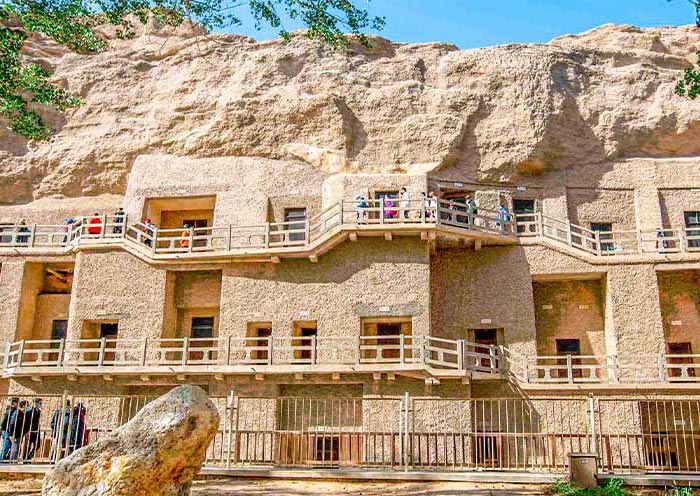
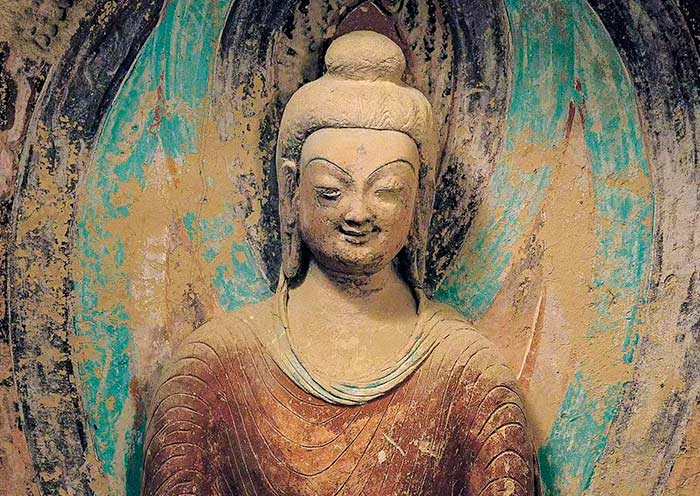
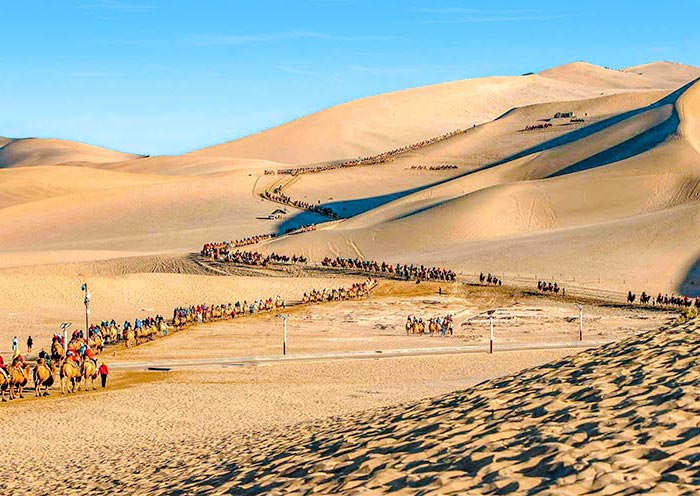

Attractions
2 sites
Transportation
coach
Dining
Breakfast
Accommodation
Dunhuang
Today, you will head to Jiayuguan (400km, 5hrs) to explore Jiayuguan City for the Great Wall on the Cliff (Overhanging Great Wall) & the Jiayuguan Pass (Jiayuguan Fortress). Jiayuguan is a good place to grasp the essence of a famous Chinese poem that goes, 'In the boundless desert, lonely smoke rises straight; Over the endless river, the sun sinks round大漠孤烟直,长河落日圆'.
You will climb the Great Wall on the Cliff (Overhanging Great Wall悬壁长城) which was acclaimed as the "end of the Great Wall". It was constructed in 1539 (Ming Dynasty) and only 750 meters remain. As the northern extension of the Jiayuguan Pass, it was built following the natural terrain, using local gravel and loess, the steepest section reaches about 45 degrees (over 200 m), earning its name for its appearance of hanging upside down in the air. After renovations in 1987, it consists of parapets, crenellations, and platforms. Two additional platforms were added at both ends, totaling three platforms. Climbing along the Great Wall trail (over 400 steps; kid-friendly ) to the highest watchtower, you can admire the magnificent scenery both inside and outside the Great Wall. From the desert landscapes beside the expressway to the towering chimneys in the oasis, every sight is breathtaking. Here, you can discover the remnants of ancient warfare and beacon fires while marveling at the wisdom of ancient military defense and the rapid development of modern civilization.
After that, visit Jiayuguan Pass (嘉峪关关城). Built in 1372, Jiayuguan is known as one of the "Three Great Passes of the Great Wall of China中国长城三大奇观之一" (Shanhaiguan Pass in the east, Zhenbeitai Terrace in the middle, and Jiayuguan Pass in the west). Standing atop the Jiayuguan Pass, a part of the UNESCO World Heritage Site "The Great Wall of China", you can feel the magnificence and grandeur of this ancient military defense structure. Jiayuguan is the Westernmost Pass of the Ming Great Wall, in the middle of the Hexi Corridor. "Jiayu" means "beautiful valley." Nestled against mountains and water, with its strategic location and majestic architecture, it is renowned as the "The Impregnable Pass under Heaven天下第一雄关."
From the Jiayuguan Pass walls, you can see the Great Wall traversing the desert and the Gobi, while the beautiful Qilian Mountains (祁连山Snow Mountains) and the Heishan Mountains (黑山) act as natural barriers, stretching across the north and south of Jiayuguan. The magnificent scene described in the elementary school Chinese textbook "The Great Wall《长城》" - "From Shanhaiguan in the east to Jiayuguan in the west, spans over 13,000 li (Chinese miles)从东头的山海关到西头的嘉峪关,有一万三千多里" - finds perfect embodiment here.
You might imagine over 600 years ago when this place was a battleground where the Great Walls were built and met with the Ancient Silk Road, connecting the Central Plains (中原) with the Western Regions (西域), and witnessing numerous commercial exchanges and cultural interactions. During the Western Han Dynasty (202 BC-8 AD), Zhang Qian (张骞) passed through here three times to open up the Western Regions, and General Huo Qubing (霍去病) departed to battle the Huns, or Xiongnu (匈奴). During the Tang Dynasty (618-907), Monk Xuanzang (玄奘) passed through here to retrieve Buddhist scriptures. Marco Polo (马可.波罗) traveled through China in the Yuan Dynasty (1206-1368) and visited Jiayuguan. In 1841 (Qing Dynasty), Lin Zexu (林则徐) was sentenced to exile in Yili, Xinjiang for his involvement in the anti-opium campaign. Passing through Jiayuguan, he composed the poem "Southeast, who compares to this mighty pass东南谁比此关雄."
Today, in Jiayuguan Fortress, you can obtain a passage permit (Optional; Self-pay) and experience the process of entering and exiting Jiayuguan as it was centuries ago. This unique experience transports you through time, back to an era where official "passes" (an early form of passport) were required for passage. The Chinese phrase "qing duo guanzhao " (请多关照literally means please take care of me; similar to nice to meet you) originates from the polite language used by people entering and exiting Jiayuguan, symbolizing mutual care and assistance.
Jiayuguan Pass/Fortress is one of the best-preserved gate cities along the Great Wall, making it a popular destination for architecture enthusiasts. It consists of three overlapping defense lines - the inner city, outer city, and moat - forming a military defense system with watchtowers every five li, beacon towers every ten li, fortresses every thirty li, and a city every hundred li. Jiayuguan is not just a city; it's a legendary tale waiting for you to uncover its secrets. Additionally, Jiayuguan is an oasis at the foot of the Qilian Snow Mountains, with numerous lakes and lush greenery, making it a rare summer retreat. Overnight stay in Jiayuguan.


Attractions
2 sites
Transportation
coach
Dining
Breakfast
Accommodation
Jiayuguan
Today, you will head to explore Zhangye City (225 km, about 3.5 hours) for Dafo Temple. Along the way, you'll stop to explore Zhangye National Geopark.
Zhangye National Geopark (Zhangye Colorful Danxia Scenic Spot七彩丹霞景区) is renowned for its strikingly colorful rock formations, often referred to as Rainbow Mountains. Zhangye is famous worldwide for its colorful Danxia landforms, a must-visit attraction for people traveling to Zhangye. This is a paradise for geologist & photography enthusiasts, and a great place to experience the marvelous work of nature. The Zhangye Colorful Danxia Scenic Spot (七彩丹霞景区), part of the Zhangye National Geopark, is China's only highly composite area that combines Danxia landforms with colorful hilly landscapes. Zhangye Danxia has been honored as one of the world's top ten geographical wonders, one of the 22 most unforgettable landscapes worldwide, and the most beautiful exterior filming location at the 74th Venice Film Festival. This location served as a filming site for the movie The Great Wall《长城》 directed by Zhang Yimou and Disney's Mulan《花木兰》. The Rainbow Mountains featured on the cover of high school English textbooks are not only geological relics of special scientific significance, rarity, and aesthetic value but also hold archaeological, ecological, historical, and cultural significance.
During the Cretaceous period, approximately 135 to 65 million years ago, the Zhangye region underwent the Himalayan orogeny, multiple erosions by water and wind, and long-term weathering processes, leading to the formation of the current Danxia landforms. The strata are mainly composed of sandstone and mudstone, formed in a dry and hot environment, where divalent iron in minerals oxidized to trivalent iron, giving the strata a red hue. As the environment gradually became wetter, the high-priced iron was reduced, causing a change in strata color to shades of brown, yellow-green, and bluish-gray, creating a palette resembling that of an overturned divine paintbox. The term "Danxia (丹霞)" originates from Cao Pi's poem (曹丕) "Danxia surrounded by the bright moon, with splendid stars emerging amidst the clouds (丹霞夹明月,华星出云间)." "Danxia," literally means the sacred or auspicious celestial sight - the rosy clouds illuminated by light. When geologists first discovered the cinnabar-colored landform, the romantic scientists named it the "Danxia landscape," leading to the coinage of the geographical term "Danxia landform (丹霞地貌)."
The scenic area comprises five Observation Decks (No. 3 and No. 2 have been merged). Shuttle buses connect each Observation Deck (entering and exiting at the north gate, with shuttle stops at four points in the order of Observation Deck #2-1-5-4). Observation Deck #1 and Observation Deck #4 are the most recommended. Yunhai Platform (云海台 No. 1) is where the image was taken on the ticket and the largest viewing platform, offering a panoramic view of the entire Danxia landscape, including the winding S-shaped road. Hongxia Platform (虹霞台 No. 4), highly popular and considered the most beautiful spot with the most vibrant colors, is the best place to watch the sunset. In the eyes of the Chinese people, the Rainbow Mountains here resemble delicious Pork Belly or Strawberry Cake layers.
At the Zhangye Rainbow Mountains, you can admire unique features like the Rainbow Screen, Sleeping Beauty, Giant Scallop, Monks Worshiping Buddha, Monkey Gazing at the Sea, Turtle Asking the Heavens, and the Red Cliff Great Wall (七彩屏、睡美人,大扇贝、众僧拜佛、灵猴观海、神龟问天、赤壁长城). Standing at the mountaintop, one can witness the colorful watercolor-like mountain ranges, feeling as if stepping into a painting.
Notes:
1. The best time for photography is at sunrise when the light is soft, colors are vivid, and there is a strong contrast, ideal for capturing both the panoramic view and detailed textures of the Rainbow Mountains. Sunset, with the setting sun casting its warm glow on the hills, creating golden silhouettes, is also an excellent time to capture the beauty of the Rainbow Mountains.If you want to capture the sunrise, do double check with your travel consultant to overnight at the hotel near the
2. Another optimal time to appreciate the Danxia landforms is after rainfall when the colors become evenmore vibrant and captivatingdue to the moisture.
3. Comfortable shoes are essential as climbing uphill sections may occur.
4. The scenic area also offers entertainment options such as camel rides, hot air balloons, gliders, helicopters, and other activities (at an additional cost).
Continue your drive to Zhangye city to visit Dafo Temple (大佛寺; Big Buddha Temple). This is a must-visit place in Zhangye if you're particularly interested in Buddhist culture and ancient architecture. The Big Buddha Temple is the iconic building of Zhangye, known for housing a 34.5-meter-long statue of the reclining Buddha, commonly called the "Reclining Buddha Temple 卧佛寺" by locals. Built in the year 1098, the Giant Buddha Temple was a royal temple built by the Western Xia Dynasty (西夏;1038-1227), making it one of the Four Remaining Royal Temples in China (the other three being the Lama Temple in Beijing, the Famen Temple in Baoji of Shaanxi, and the Chongsheng Temple in Dali of Yunnan). Legend has it that Kublai Khan (忽必烈), the founder of the Yuan Dynasty (1271-1368), was born in the Big Buddha Temple in Zhangye. The Italian traveler Marco Polo was captivated by the magnificent architecture of the Giant Buddha Temple and the prosperity of Zhangye, leading him to stay there for a year. Covering an area of over 60,000 m², the temple could accommodate 5,000 worshipers simultaneously in the 16th century.
Visit Big Buddha Temple in Zhangye to explore the only surviving Western Xia temple in China, the largest indoor reclining Buddha in Asia, and the complete Yongle Canon and Prajna Paramita Sutra (《永乐北藏》). It is a Buddhist art museum that integrates architecture, sculpture, murals, carvings, scriptures, calligraphy, and cultural relics. When you step into the temple, you'll see the Grand Buddha Hall which has maintained its original appearance from over 900 years ago. Besides the reclining Buddha, the walls on the east and west sides of the hall feature murals inspired by "Journey to the West西游记," "Investiture of the Gods封神演义," and the "Classic of Mountains and Seas山海经." Among these, the "Journey to the West" mural is said to predate the novel by approximately 200 years, depicting the story of Tang Dynasty Monk Xuanzang (唐僧) and his disciples embarking on their journey to the West in a comic strip format, showcasing episodes like "Fetching Water from the Motherhood River," "A Battle with Red Boy," "Obstacle at Flaming Mountain," "The Monkey King: Uproar in Heaven," and "Expulsion of the Monkey King/Wukong" (取水子母河、大战红孩儿、路阻火焰山、大圣闹天宫、恨逐美猴王). Interestingly, the character Zhu Bajie (猪八戒) in the mural is portrayed as simple, honest, and hardworking, in stark contrast to the Zhu Bajie character in the novel Journey to the West. Even today, within the Zhangye region, one can find many place names from novel Journey to the West, such as Gaolaozhuang (高老庄Bajie's hometown), Liusha River (流沙河), Liangjintai (晾金台), Bull Demon King's Cave (牛魔王洞), and the Eight Thousand Ruoshui River(八千里弱水).
A pair of Chinese characters written on a couplet outside the Grand Buddha Hall reads, "The Sleeping Buddha slumbers a thousand years without awakening, those who inquire will forever question, the answer remains elusive睡佛长睡睡千年长眠不醒,问者永问问百世永问难明," provoking deep contemplation and worth a look. Remember to ask the guide to show you another pair of couplets written in the Western Xia script with the same content. Additionally, the scripture hall of the reclining Buddha temple houses a Buddhist art exhibition hall and a Buddhist scripture exhibition hall, showcasing Buddhist artifacts extracted from the Buddha's abdomen. Among them, the "Mahaprajnaparamita Sutra《大般若波罗蜜多经》" written in gold and silver ink is a treasured artifact. Rare and exquisite Persian silver coins have been discovered in this temple, serving as compelling evidence of the bustling foreign trade along the Silk Road.
Note:
Currently, the reclining Buddha statue in Zhangye Giant Buddha Temple is undergoing digital restoration, covered by scaffolding. The project is expected to be completed by June 2025.
Stay Overnight in Zhangye City.
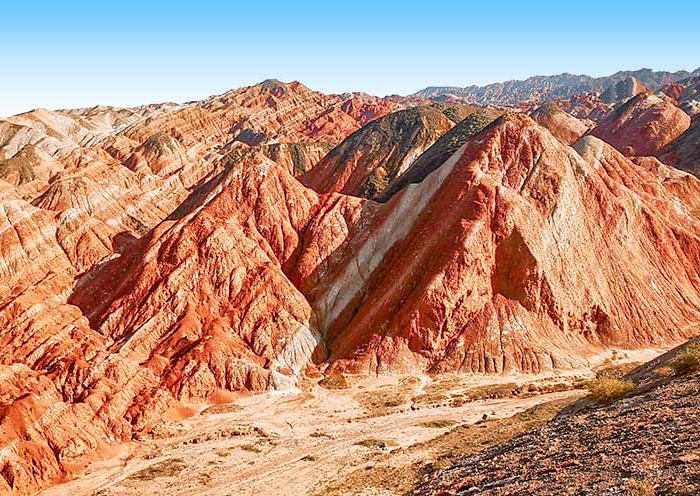
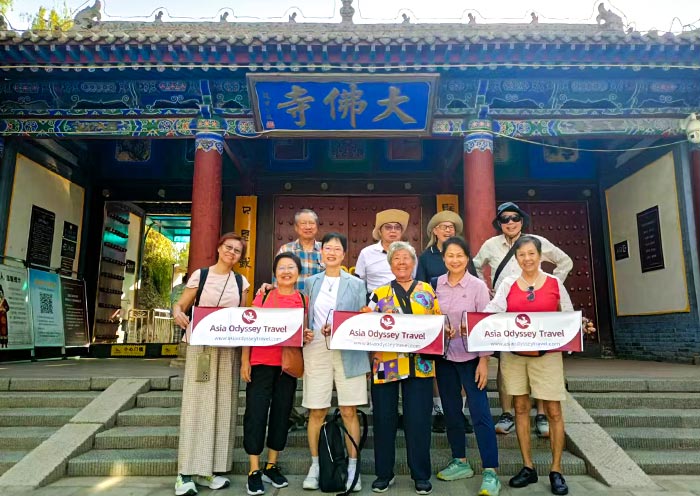
Attractions
2 sites
Transportation
coach
Dining
Breakfast, Lunch
Accommodation
Zhangye
After breakfast at your hotel, proceed to the Zhangye railway station and board the high-speed train bound for Xining. Upon arrival at the train station in Xining, your guide and driver will meet you at the exit and then escort you to Qinghai Lake (about 145 km, 2.5-3 hours).
Qinghai Lake (青海湖), sitting at an elevation of 3,194 meters above sea level, is China’s largest inland saltwater lake, covering over 4,400 square kilometers. The lake is surrounded by majestic mountain ranges, including the snow-capped Kunlun Mountains to the south and the Qilian Mountains to the north. The landscape transitions from vast, flat grasslands at the foot of the mountains to the lakeshore. In summer, golden fields of canola flowers contrast beautifully with the lake’s boundless blue waters. Wildflowers dot the grasslands, and countless cattle and sheep graze like pearls scattered across a majestic yet serene painting. National Geographic China has named Qinghai Lake "China's most beautiful lake", and it's listed as one of the "55 must-see places in a lifetime". With a comfortable summer average temperature of 15°C, it is a popular retreat and photography destination.
As you drive, you'll pass through vibrant rapeseed fields around the lake, a sea of yellow flowers stretching across the horizon - an unforgettable display of earthly beauty. (Best Time to Visit: July to August, when the weather is pleasant, and the rapeseed flowers and grasslands are in full bloom.)
Upon arrival, you will explore the Erlangjian Scenic Area (二郎剑景区), Qinghai Lake's crown jewel. Be captivated by the panoramic views of the vast, turquoise lake. On clear days, enjoy views of distant snow-capped mountains. Discover the rich cultural heritage of the area, including the awe-inspiring sacrificial altar, vibrant prayer flags, the enigmatic statue of the Queen Mother of the West, the auspicious symbols, and a serene Buddha statue.
Optional Activities - self-pay on your own: To fully immerse in the beauty of the expansive lake, consider taking a cruise to experience Qinghai Lake in comfort. Choose from the High-Speed Cruise (25-minute single trip for CNY140) or the Catamaran Cruise (50-minute round trip for CNY180). Also, you can go horseback riding or enjoy biking around the lake.
After exploring Erlangjian Scenic Area, continue your trip westward along the picturesque shores of Qinghai Lake. The drive to Chaka Town (3,100 meters) is about 153km, taking about 2.5 hours. This charming town is renowned for the stunning Chaka Salt Lake it boasts. Spend the night in Chaka Town.
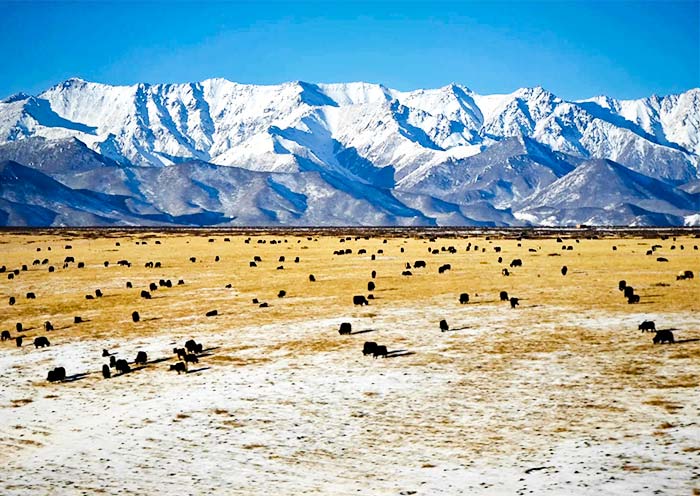

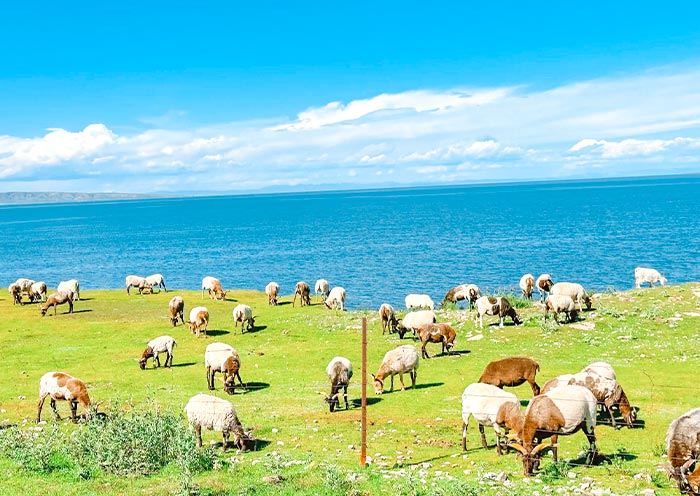
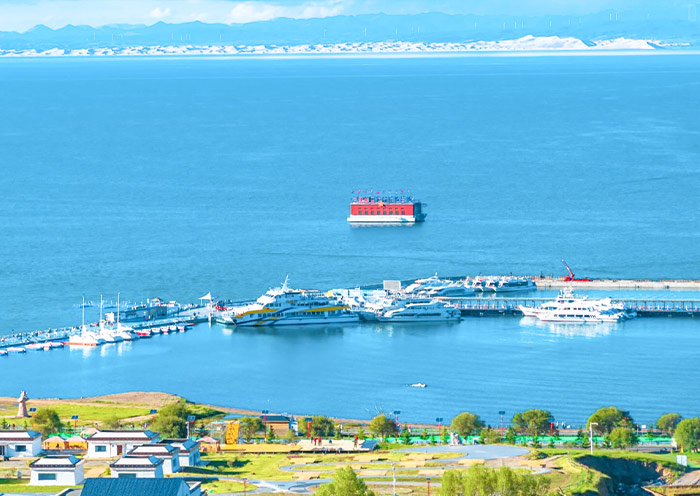
Attractions
1 site
Transportation
high speed train, coach
Dining
Breakfast
Accommodation
Chaka Town
In this morning, you will be transferred from Chaka Town to Chaka Salt Lake (茶卡盐湖, 4km, 10 minutes’drive).
“Chaka" is a Tibetan word meaning "salt lake". As a salt lake, it is one of the birthplaces of China's salt culture. Embedded amidst snow-kissed peaks and verdant meadows, Chaka is a brine lake, a harmonious blend of liquid and solid. Its waters, a shimmering expanse of blue, are interspersed with crystalline salt flats. The lake's beauty is enhanced by the dramatic backdrop of snow-capped mountains and the gentle caress of surrounding grasslands. It is a natural masterpiece, adorned with salt formations of exquisite shapes.
You will visit the "Mirror of the Sky" Scenic Area, a stunning destination known for its breathtaking reflections. Start your journey by ascending the Observation Tower, where you can take in a full panoramic view of Chaka Salt Lake. Next, explore the Salt Sculpture Group, the largest outdoor sculpture display in the world, showcasing the rich history and culture of Chaka. For an even more immersive experience, hop on the sightseeing train that takes you deep into the lake’s heart, away from the crowds. From there, you can leisurely walk back toward the entrance, a stroll that takes about 40 minutes. If you prefer not to walk, you can return by train (additional cost).
As you walk, visit the Qianying Muxue Area, where the lake and the distant snow-capped mountains blend into a breathtaking natural scene. Along the way, stop for photos at the Tianlu Yingchen Station and Tianji Xinyue Station, where you can capture iconic images with signs like “I Love Chaka” and “Love Crystals”.
Useful Travel Tips:
(1)To experience the salt lake up close, you can wear shoe covers (10 CNY extra fee) and walk on the lake surface, capturing reflections that resemble a "mirror of the sky," as if you're walking among the clouds.
(2)Riding the sightseeing train offers stunning views of endless white sea salt sands under the blue sky, with the lake reflecting the sky above.
(3)Every corner of Chaka Salt Lake is perfect for photography. Some of the top spots include Romantic Tianjing, Qianying Muxue, the Water Train, and areas near the salt sculptures. The Romantic Tianjing area is especially picturesque with photo props like crystal bubble chairs, a crystal boat, the famous swing, heart-shaped decorations, a moon-shaped frame, and the red piano sculpture "Chaka’s Melody".
(4)For spectacular shots of the sunrise or sunset over Chaka Salt Lake, head to the salt sculpture area or Chaka Xia Station for beautiful views.
After exploring Chaka Lake, you'll return to Xining, covering about 300 km over 3.5 to 4 hours. Stay overnight in Xining downtown area.

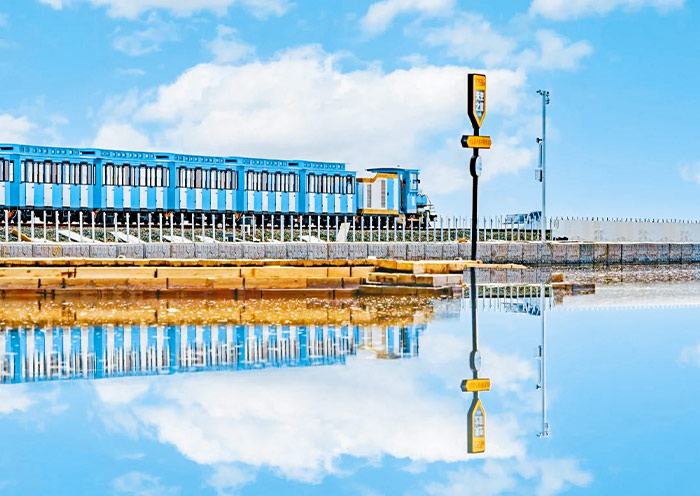
Attractions
1 site
Transportation
coach
Dining
Breakfast
Accommodation
Xining City
After breakfast, you will go to Kumbum Monastery, also known as Ta’er Monastery (塔尔寺), located about 30km from the downtown are (about 40 minutes’ drive). As one of the six grand monasteries of the Gelug sect of Tibetan Buddhism, it holds immense significance as the most important Buddhist center in Qinghai. Established in 1577, Ta'er Monastery is built around the birthplace of Tsongkhapa, the revered founder of the Gelugpa sect. The monastery is renowned for its three artistic wonders: exquisite butter sculptures, vibrant murals, and intricate appliqué Thangka, all showcasing the unique artistry of Tibetan Buddhism.
During your visit, you'll be impressed by the blend of Tibetan and traditional Chinese architectural styles. You'll admire magnificent Buddha stupas, wall paintings, and prayer wheels, while exploring its stunning halls one by one. These include the Eight-Treasure Auspicious Pagoda, Small Golden-Roofed Hall, Longevity Hall, Kalachakra Pagoda, Great Scripture Hall, Great Golden-Roofed Hall, Maitreya Buddha Hall, Nine-Room Hall, Kalachakra Scripture College, Butter Sculpture Hall, and the Scripture Library - each offering a glimpse into the monastery's spiritual depth and artistic heritage.
After the tour, it is time to end your unforgettable 10 Days Silk Road group tour. Your guide and driver will ensure a smooth transfer to the airport or train station for your departure.
Thank you for choosing Asia Odyssey Travel for your China tour. We are dedicated to enhancing your travel experiences and look forward to welcoming you on your next adventure in China and other destinations in Asia. Have a safe journey home!
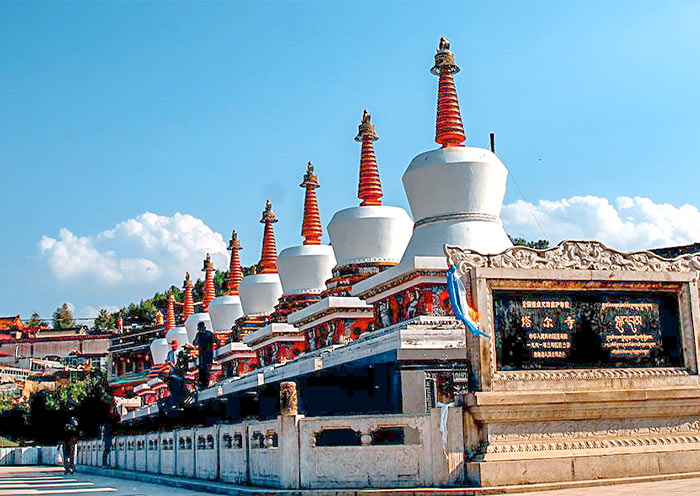

Attractions
1 site
Transportation
coach
Dining
Breakfast
Accommodation
/
Choose Your Travel Date and Get Free Enquiry
| Month | Available Date | Price | Book The Tour |
|---|---|---|---|
| Apr | Apr.21, 2025 | from $1328 | Free Enquiry |
| May | May.10, 2025 | from $1328 | Free Enquiry |
| May.19, 2025 | from $1328 | Free Enquiry | |
| Jun | Jun.02, 2025 | from $1328 | Free Enquiry |
| Jun.07, 2025 | from $1328 | Free Enquiry | |
| Jun.16, 2025 | from $1328 | Free Enquiry | |
| Jun.30, 2025 | from $1328 | Free Enquiry | |
| Jul | Jul.14, 2025 | from $1378 | Free Enquiry |
| Jul.28, 2025 | from $1378 | Free Enquiry | |
| Aug | Aug.11, 2025 | from $1378 | Free Enquiry |
| Aug.25, 2025 | from $1378 | Free Enquiry | |
| Sep | Sep.08, 2025 | from $1328 | Free Enquiry |
| Sep.13, 2025 | from $1328 | Free Enquiry | |
| Sep.27, 2025 | from $1328 | Free Enquiry | |
| Oct | Oct.06, 2025 | from $1328 | Free Enquiry |
| Oct.11, 2025 | from $1328 | Free Enquiry | |
| Oct.20, 2025 | from $1328 | Free Enquiry |
Price: What’s Included & What’s Excluded
What’s Included:
What’s Excluded:
- 01 Group Policy: Typically, Silk Road small group tours will have 1-25 travelers, and you will have the opportunity to meet and travel with tourists from different parts of the world.
-
02
Transportation for Group Tours:
In a Silk Road Group tour, it means you will transfer to the tourist attractions by coach. The maximum group size will be 25 people. It will be a small group size traveling at comfortable pace. The coach we selected is spacious and comfortable. As for traveling between two destinations, we use flights or high speed trains (second class seat, usually less than 6 hours). The local drivers will pick you up at the airport/train stations, and escort you to the hotel. -
03
Additional Cost for Private Transfer:
(1) For arrival and departure transfers (1-2 persons): Early arrivals or late departures will incur an additional transfer fee.
(2) For flights arriving after 22:00 and departing before 09:00: An additional transfer fee will apply. -
04
Child Pricing Policy:
(1) Occupying a bed: Children will be charged the adult rate. (2) Not occupying a bed: Children will be charged the group tour fee minus the single room difference. Any ticket discounts will be refunded. -
05
Cancellation Policy:
30-45 days before departure: 10% of the tour fee.
29-15 days before departure: 30% of the tour fee.
14-7 days before departure: 50% of the tour fee.
6-0 days before departure: 100% of the tour fee.
Hotel Conditions for Silk Road Group Tours
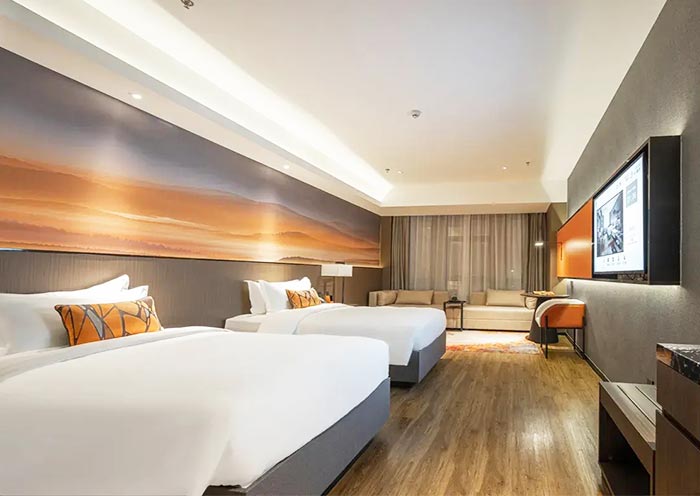

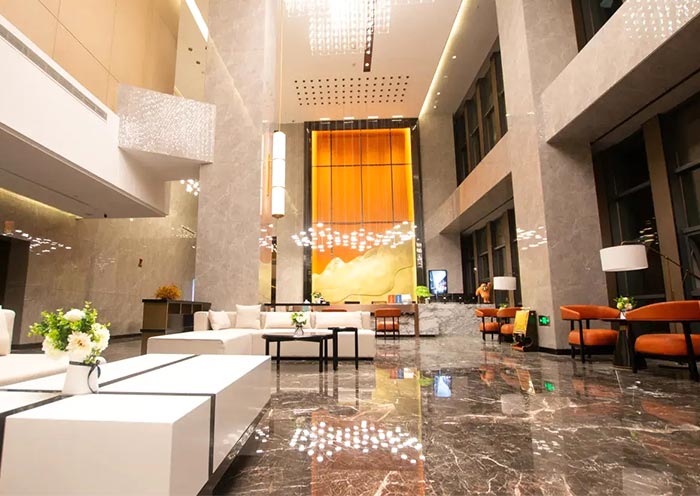
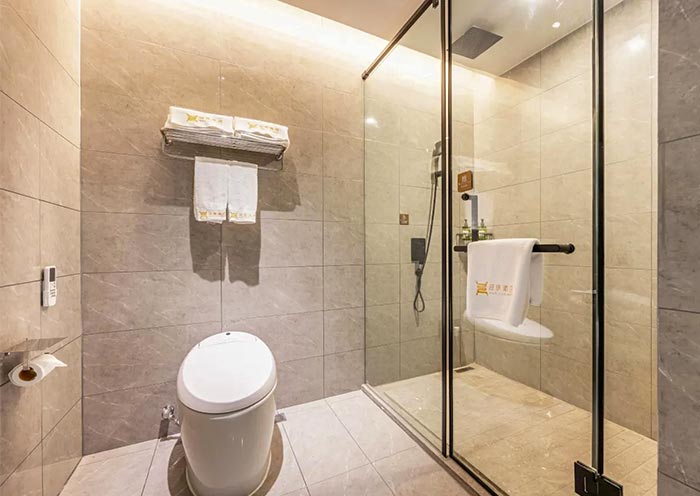
3-Star Hotels on the Silk Road Route Destinations:
Enjoy comfortable 3-star hotels along the Silk Road route, offering essential amenities for a relaxing stay after each day's adventures. These hotels provide a welcoming atmosphere with friendly service, perfect for Silk Road travelers.
Recommended Length to Stay (Xinjiang, Gansu & Qinghai)
To fully experience the Silk Road's highlights, we recommend a group tour of 5-12 days. (1) One-Destination Deep Dive: Immerse yourself in the wonders of either Xinjiang (3-5 Days) or Gansu (5 Days). (2) Classic Silk Road Experience: Combine Xinjiang and Gansu together for a comprehensive exploration.(3) Ultimate Silk Road Journey: Extend your trip to include Qinghai and experience China’s diverse landscapes.
Standard Twin Room
Standard twin rooms on Silk Road group tours feature two comfortable beds, private bathrooms, and basic amenities. These rooms are designed for travelers seeking a cozy, convenient space to rest and recharge during their Silk Road journey.
Latest Silk Road Group Tours Reviews from Our Customers

Coldy
UK
We did a 4 night cruise on the Yangtze river as part of our tour. The ship is not as luxurious as the river cruise ships in Europe but was more than fine. Meals were great and staff was terrific. Upon arrival at the ship signs were on the table stating upgraded cabins were available. We had read about this in travel blogs before our trip. Breakfast was a buffet and you selected your dinner choices from an extensive list of options at that time. The staff put on a floor show every night in the main lounge sometimes including some passengers. All in all we had a great time and would recommend this cruise.
Destination(s): Qinghai, Dunhuang/Gansu
Date of Experience: Aug 16, 2023
Tour Customized by: Owen
You May be Interested in This Tour: Victoria Sabrina

Ju Le
Malaysia
Northern Xinjiang took my breath away with its endless natural beauty. While I’d heard of Kanas Lake, discovering Hemu Village, the picturesque Saramy Lake, and the vibrant Wucaitan Danxia formations added so much more. Urho Ghost City’s mysterious landscapes and the relaxing, scenic spots around each lake made every day exciting. This area is an absolute paradise for nature lovers!
Destination(s): Dunhuang/Gansu
Date of Experience: Sep 07, 2024
Tour Customized by: Owen
You May be Interested in This Tour: 8 Days Northern Xinjiang Group Tour: Kanas Lakes, Hemu Village & Sayram Lake

Zhen Xin
Hong Kong
Dunhuang’s stunning desert and artistic treasures made for an unforgettable experience! The Mogao Caves were filled with remarkable historical art, while the desert landscape offered the thrill of camel riding and hiking up the sand dunes. Reaching the top rewarded us with panoramic views of the magical Crescent Lake nestled among the dunes. It was a surreal mix of history, art, and adventure!
Destination(s): Dunhuang/Gansu
Date of Experience: Aug 18, 2024
Tour Customized by: Owen
You May be Interested in This Tour: 6 Days Best Gansu Tour from Dunhuang to Jiayuguan & Zhangye
